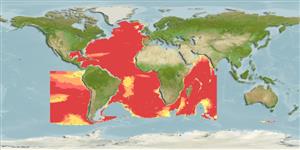Environment: milieu / climate zone / depth range / distribution range
Οικολογία
Θαλασσινό(ά) βαθυπελαγικό(ς); εύρος βάθους ? - 2500 m (Ref. 58018), usually 1500 - ? m (Ref. 6649). Deep-water
Atlantic, Indian and Pacific: in tropical and subtropical waters. Known from relatively few scattered localities from the Gulf of Mexico to the eastern Pacific off Ecuador. Eastern Atlantic: known from four stations ca 24°N to 19°S, not known from the Benguela Current/Gulf of Guinea area.
Μέγεθος / Βάρος / Age
Maturity: Lm ? range ? - ? cm
Max length : 26.0 cm SL αρσενικό/απροσδιόριστο; (Ref. 6944)
Short description
Κλείδες προσδιορισμού | Μορφολογία | Μορφομετρία
Ραχιαίες άκανθες (συνολικά) : 11 - 13; Μαλακές ραχιαίες ακτίνες (συνολικά) : 22 - 25; Εδρικές άκανθες: 1; Μαλακές εδρικές ακτίνες: 22 - 25.
Most adults were caught at depths exceeding 1,500 m (Ref. 6764).
Life cycle and mating behavior
Maturities | Αναπαραγωγή | Spawnings | Egg(s) | Fecundities | Προνύμφες
Johnson, R.K. and M.J. Keene, 1986. Chiasmodontidae. p. 731-734. In M.M. Smith and P.C. Heemstra (eds.) Smiths' sea fishes. Springer-Verlag, Berlin. (Ref. 6649)
IUCN Red List Status (Ref. 130435)
Threat to humans
Harmless
Human uses
αλιεία: χωρίς ενδιαφέρον
Εργαλεία
Special reports
Download XML
Διαδικτυακές πηγές
Estimates based on models
Preferred temperature (Ref.
123201): 2.1 - 5.1, mean 4 °C (based on 245 cells).
Phylogenetic diversity index (Ref.
82804): PD
50 = 0.5078 [Uniqueness, from 0.5 = low to 2.0 = high].
Bayesian length-weight: a=0.00389 (0.00180 - 0.00842), b=3.12 (2.94 - 3.30), in cm total length, based on all LWR estimates for this body shape (Ref.
93245).
Τροφικό Επίπεδο (Ref.
69278): 3.8 ±0.2 se; based on size and trophs of closest relatives
Fishing Vulnerability (Ref.
59153): Low vulnerability (22 of 100).
